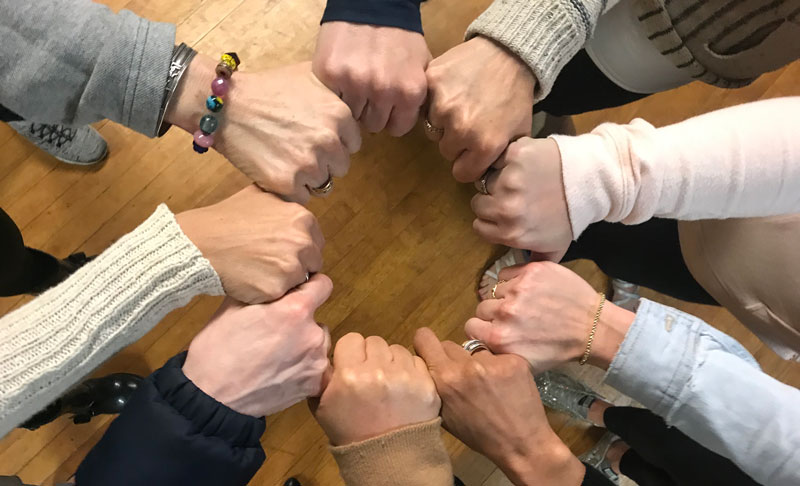
Life is too short to listen to mel robbins
There’s been a lot of buzz about an op-ed published in the New York Times right before Thanksgiving entitled, Life is Too Short…
...
Anger management is an oxymoron. There, I said it.
Can you learn skills that will enable you to potentially walk away from a conflict before your body has escalated to the point of no return? Absolutely.
But to think that anger can be managed, when what it really needs to do is be safely released, is oxymoronic. Anger – otherwise known as the fight response in Polyvagal Theory – is a normal reaction to a real or perceived threat.
What people in “anger management” classes are really trying to manage is their rage. So let’s talk about the difference between those two things. According to Susan Aaron, creator of Psychodramatic Bodywork®, anger is a grounded and empowered emotion. I feel the activation of anger, and I can be in my body, as opposed to being checked out.
I can be in control of my emotions, and I can be appropriate in how I release it. I can speak directly to the person with whom I’m angry, with my eyes open, telling them my concerns in a low and grounded voice.
When anger isn’t expressed, it shows up in the body in a multitude of ways.
For some people, anger lives in their jaw. For those of you who, like me, wear a night guard, because you grind or you clench your teeth, it’s likely you have some unprocessed anger in your body, or some trauma that hasn’t been cleared that is manifesting as a fight response.
Or maybe your anger lives in your shoulders. They’re tight and they’re painful.
Or maybe you’re often tired or you have a headache or you feel kind of sluggish. In Chinese medicine, things like acupuncture or shiatsu, anger lives in the liver. So if you’re constantly angry, your liver, which is your filtration system, is going to get clogged and you’ll likely experience some of those things.
For many of us, we weren’t allowed to have our anger. It’s not “ladylike” or it’s not allowed in this family or it was too dangerous to show it.
Or maybe we’re afraid of it. So we just learned to suppress it. My anger didn’t show up until later in my adolescence because I had been such a good girl for so long, meaning I had suppressed it. So it came out sideways. I was passive aggressive. I was sarcastic.
And a lot of times when I was angry, I expressed it inappropriately. I learned how to override my true feelings and carry on as though everything was fine.
But here’s the thing…if you continue to suppress anger, it is eventually going to explode like a volcano.
After an anger explosion, or an expression of rage, you’ll end up with what I call a “shame hangover.” People end up asking themselves things like,
“Why did I speak to my _____________ (child, partner, parent, etc)?
Why did I fly off the handle like that?
What’s wrong with me?”
Unlike anger, which is expressed in a grounded way, when someone is enraged, their fear highjacks their system and they can very quickly go out of control.
Their voice becomes high-pitched, often their eyes close, thus the term blind rage, and interestingly, their heels tend to come off the ground, so they are literally ungrounded. Often rage emerges when someone has started out as angry, and then they get scared that they aren’t going to get what they want, so it escalates.
And often, it’s covering something that feels vulnerable, like a need that they’re afraid isn’t going to get met. For many of us, it’s connected to unexpressed needs we had as a child or adolescent. And in an adult body, anger feels much more powerful than tears or fear.
With rage, instead of speaking in a low-register, grounded voice, all of a sudden, very quickly, the voice can escalate in both volume and pitch – meaning the sound of their voice is higher – and what started out as anger is now fury. And when someone’s in a rage, that out-of-control energy can be downright dangerous, so it’s important to get out of the way if it happens.
One way to do this is by using a tackle dummy, which we do in Psychodramatic Bodywork® – is a therapeutic modality created by Susan Aaron. I’m a trainer of that method, and we use a specially designed tackle dummy, which has a softer top, that makes it safe to hit.
(You can find information about Psychodramatic Bodywork at Susan’s website – youremotions.com or on this page on my site
But an VERY important point regarding anger releases is that when we use a tackle dummy, we’re not engaging in violence. We aren’t imagining beating up someone. It’s simply a vehicle for releasing the energy out of our body. That’s a very, very important distinction.
In a therapeutic context, you can imagine there is a person or an institution that you’re angry with in an empty chair, and then hit the tackle dummy to help you release the angry energy out of your body, while your words or sounds, and your eyes are directed at that empty chair.
There is extensive training that is required to facilitate this kind of emotional release, especially because it can escalate to rage. So if you’re a behavioral health practitioner who is not trained in release work, please don’t try this at home, as I like to say. And if you’re in therapy, and your therapist suggests you engage in this kind of release work, you have every right to ask them what kind of training they’ve had in order to facilitate your release.
So many people who are sent to “anger management” classes are there because their system is in high activation. They very easily get overwhelmed, which results in outbursts that they don’t know how to “manage.”
Once a trigger happens in the body, rage moves quickly, like a wildfire, and it’s very difficult for someone to stop it. So rather than shaming someone for their inability to “manage” their rage or manage their anger, it’s important to frame the behavior as a trauma response. The fight response is a healthy reaction to perceive danger.
Rather than teaching people how to override and suppress their anger, which will just result in it coming out sideways, why not help them explore it therapeutically? Help them understand why it emerges. Help them express some appreciation for it, for keeping them safe.
Help them befriend it. Help them learn how to expand their window of presence – that is, their ability to stay present and grounded despite what’s occurring around them. And then use their resources like friends, their pets, their relationships with the Divine, with family, with self-help groups, to turn to when they start to feel their energy rising.
Help them to learn how to maintain a calmer nervous system. Let’s help them experience what it feels like through a technique like Psychodramatic Bodywork® to release their fear – to help uncouple it from their anger – so that they begin to identify that they are two separate emotions.
Through Psychodrama and Psychodramatic Bodywork®, they can actually learn how to express anger appropriately, so they can be heard. It will also give them a greater chance of actually getting what they wanted in the first place – which is to be seen; to be acknowledged, and/or to be understand.
It can also help them learn how to compromise and manage their feelings when they don’t get exactly what they want. Through action methods, and emotional release work, we can help them find safe ways to release the angry energy, so that they can begin to spot a trigger earlier, and engage in activities, like going for a run, or going to a kickboxing class, or hitting a speed ball at the gym.
Or, like I used to do, going to a batting cage. By engaging in the movement of hitting the ball (again, not hitting someone, but imagining that the person I was angry with was behind the ball machine, and using the bat and my voice to release the energy).
Or nowadays, something that has become VERY popular is to gather in a group to scream. There are groups in Chicago, for example, who stand along the river, and all scream together, to release pent up energy in their bodies, so they can come back to a state of calmness.
So I would invite you to think about what you do or can do to let off some of that steam, and lower the temperature on your own emotional state, and tune in to what it is underneath that anger and/or fear that you were seeking in the first place.
This material is protected by copyright.

There’s been a lot of buzz about an op-ed published in the New York Times right before Thanksgiving entitled, Life is Too Short…
...
Early on in my training, I was taught that the sign of a healthy group is that the sociometry is…
...